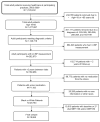Progression is accelerated from prehypertension to hypertension in blacks
- PMID: 21911708
- PMCID: PMC3186683
- DOI: 10.1161/HYPERTENSIONAHA.111.177410
Progression is accelerated from prehypertension to hypertension in blacks
Abstract
Prehypertension is a major risk factor for hypertension. Blacks have more prevalent and severe hypertension than whites, but it is unknown whether progression from prehypertension is accelerated in blacks. We examined this question in a prospective cohort study of 18 865 nonhypertensive persons (5733 black [30.4%] and 13 132 white [69.6%]) aged 18 to 85 years. Electronic health record data were obtained from 197 community-based outpatient clinics in the Southeast United States. Days elapsing from study entry to hypertension diagnosis, mainly blood pressure ≥140 mm Hg systolic and/or ≥90 mm Hg diastolic on 2 consecutive visits established conversion time within a maximum observation period of 2550 days. Cox regression modeling was used to examine conversion to hypertension as a function of race, while controlling for age, sex, baseline systolic and diastolic blood pressures, body mass index, diabetes mellitus, and chronic kidney disease. The covariable adjusted median conversion time when 50% became hypertensive was 365 days earlier for blacks than whites (626 versus 991 days; P<0.001). Among covariables, baseline systolic blood pressure 130 to 139 mm Hg (hazard ratio: 1.77 [95% CI: 1.69 to 1.86]) and 120 to 129 mm Hg (hazard ratio: 1.52 [95% CI: 1.44 to 1.60]), as well as age ≥75 years (hazard ratio: 1.40 [95% CI: 1.29 to 1.51]) and 55 to 74 years (hazard ratio: 1.29 [95% CI: 1.23 to 1.35]) were the strongest predictors of hypertension. Additional predictors included age 35 to 54 years, diastolic blood pressure 80 to 89 mm Hg, overweight and obesity, and diabetes mellitus (all P<0.001). Conversion from prehypertension to hypertension is accelerated in blacks, which suggests that effective interventions in prehypertension could reduce racial disparities in prevalent hypertension.
Figures


Comment in
-
Epidemiological issues are not simply black and white.Hypertension. 2011 Oct;58(4):546-7. doi: 10.1161/HYPERTENSIONAHA.111.178541. Epub 2011 Sep 12. Hypertension. 2011. PMID: 21911712 No abstract available.
-
Prehypertension: to treat or not to treat should no longer be the question.Hypertension. 2012 Apr;59(4):e27; author reply e28. doi: 10.1161/HYPERTENSIONAHA.111.190678. Epub 2012 Feb 27. Hypertension. 2012. PMID: 22371356 No abstract available.
References
-
- Robinson S, Brucer M. Range of normal blood pressure: A statistical and clinical study of 11,383 persons. Arch Int Med. 1939;64:409–444.
-
- Chobanian AV, Bakris GL, Black HR, Cushman WC, Green LA, Izzo JL, Jr, Jones DW, Materson BJ, Oparil S, Wright JT, Jr, Roccella EJ. Seventh report of the Joint National Committee on Prevention, Detection, Evaluation, and Treatment of High Blood Pressure. Hypertension. 2003;42:1206–1252. - PubMed
-
- Julius S, Nesbitt SD, Egan BM, Weber MA, Michelson EL, Kaciroti N, Black HR, Grimm RH, Jr, Messerli FH, Oparil S, Schork MA. Feasibility of treating prehypertension with an angiotensin-receptor blocker. N Engl J Med. 2006;354:1685–1697. - PubMed
-
- Egan BM, Julius S. Prehypertension: risk stratification and management considerations. Curr Hypertens Rep. 2008;10:359–366. - PubMed
-
- Leitschuh M, Cupples LA, Kannel W, Gagnon D, Chobanian A. High-normal blood pressure progression to hypertension in the Framingham Heart Study. Hypertension. 1991;17:22–27. - PubMed
Publication types
MeSH terms
Grants and funding
LinkOut - more resources
Full Text Sources
Medical

